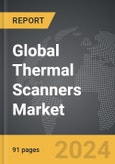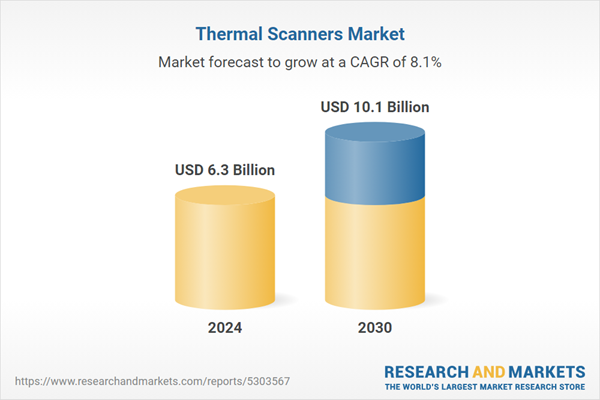The global market for Thermal Scanners was valued at US$6.3 Billion in 2024 and is projected to reach US$10.1 Billion by 2030, growing at a CAGR of 8.1% from 2024 to 2030. This comprehensive report provides an in-depth analysis of market trends, drivers, and forecasts, helping you make informed business decisions. The report includes the most recent global tariff developments and how they impact the Thermal Scanners market.
Segments: Type (Fixed, Handheld); End-Use (Aerospace & Defense, Industrial, Oil & Gas, Automotive, Commercial, Healthcare, Other End-Uses).
Geographic Regions/Countries: World; United States; Canada; Japan; China; Europe (France; Germany; Italy; United Kingdom; Spain; Russia; and Rest of Europe); Asia-Pacific (Australia; India; South Korea; and Rest of Asia-Pacific); Latin America (Argentina; Brazil; Mexico; and Rest of Latin America); Middle East (Iran; Israel; Saudi Arabia; United Arab Emirates; and Rest of Middle East); and Africa.
The analysts continuously track trade developments worldwide, drawing insights from leading global economists and over 200 industry and policy institutions, including think tanks, trade organizations, and national economic advisory bodies. This intelligence is integrated into forecasting models to provide timely, data-driven analysis of emerging risks and opportunities.
Global Thermal Scanners Market - Key Trends and Drivers Summarized
How Are Thermal Scanners Improving Safety and Efficiency?
Thermal scanners are devices that detect and visualize heat signatures, converting infrared radiation into visible images. They are widely used for temperature screening, surveillance, industrial inspection, and medical diagnostics, offering real-time, non-contact temperature measurement. Thermal scanners are critical for detecting fever, monitoring machinery, identifying insulation issues, and ensuring safety in industrial processes. As safety and preventive measures become top priorities across industries, thermal scanners have gained significant importance in public safety, healthcare, and industrial sectors, driving advancements in thermal imaging technologies.What Are the Key Segments in the Thermal Scanners Market?
Key types include handheld, mounted, and integrated thermal scanners, with handheld scanners holding the largest market share due to their portability, ease of use, and versatility in various settings. Applications cover fever detection, industrial inspection, surveillance, and diagnostics, with fever detection representing a significant segment driven by increased focus on public health screening during the COVID-19 pandemic. End-users include healthcare facilities, airports, manufacturing units, and law enforcement agencies, with healthcare facilities dominating the market as thermal scanners are essential for detecting fever and maintaining infection control in hospitals.How Are Thermal Scanners Integrated Across Industries?
In healthcare, thermal scanners are used for fever screening at hospital entrances, ensuring early detection of infectious diseases and preventing the spread of illnesses. In airports and public venues, thermal scanners support mass screening, identifying passengers with elevated body temperatures quickly and efficiently. In industrial settings, thermal scanners are used to monitor equipment temperatures, detecting overheating or insulation failures, thereby preventing accidents and downtime. Additionally, in law enforcement, thermal scanners enhance surveillance and search operations, identifying hidden objects, tracking movements, and improving safety in critical situations.What Factors Are Driving the Growth in the Thermal Scanners Market?
The growth in the Thermal Scanners market is driven by several factors, including increasing focus on public health safety, rising demand for industrial safety solutions, and advancements in thermal imaging technologies. Innovations like AI-based analytics, higher resolution imaging, and integration with IoT systems have supported broader applications in healthcare, surveillance, and industrial monitoring. The focus on improving safety, preventing equipment failures, and ensuring rapid temperature screening has further fueled demand, as thermal scanners offer efficient and accurate temperature measurement solutions. Additionally, expanding healthcare infrastructure, rising safety regulations, and growing investments in industrial automation have contributed to market growth, encouraging the adoption of thermal scanners across sectors.Report Scope
The report analyzes the Thermal Scanners market, presented in terms of units. The analysis covers the key segments and geographic regions outlined below.Segments: Type (Fixed, Handheld); End-Use (Aerospace & Defense, Industrial, Oil & Gas, Automotive, Commercial, Healthcare, Other End-Uses).
Geographic Regions/Countries: World; United States; Canada; Japan; China; Europe (France; Germany; Italy; United Kingdom; Spain; Russia; and Rest of Europe); Asia-Pacific (Australia; India; South Korea; and Rest of Asia-Pacific); Latin America (Argentina; Brazil; Mexico; and Rest of Latin America); Middle East (Iran; Israel; Saudi Arabia; United Arab Emirates; and Rest of Middle East); and Africa.
Key Insights:
- Market Growth: Understand the significant growth trajectory of the Fixed segment, which is expected to reach US$6.7 Billion by 2030 with a CAGR of a 8.4%. The Handheld segment is also set to grow at 7.5% CAGR over the analysis period.
- Regional Analysis: Gain insights into the U.S. market, valued at $1.6 Billion in 2024, and China, forecasted to grow at an impressive 11.7% CAGR to reach $2.5 Billion by 2030. Discover growth trends in other key regions, including Japan, Canada, Germany, and the Asia-Pacific.
Why You Should Buy This Report:
- Detailed Market Analysis: Access a thorough analysis of the Global Thermal Scanners Market, covering all major geographic regions and market segments.
- Competitive Insights: Get an overview of the competitive landscape, including the market presence of major players across different geographies.
- Future Trends and Drivers: Understand the key trends and drivers shaping the future of the Global Thermal Scanners Market.
- Actionable Insights: Benefit from actionable insights that can help you identify new revenue opportunities and make strategic business decisions.
Key Questions Answered:
- How is the Global Thermal Scanners Market expected to evolve by 2030?
- What are the main drivers and restraints affecting the market?
- Which market segments will grow the most over the forecast period?
- How will market shares for different regions and segments change by 2030?
- Who are the leading players in the market, and what are their prospects?
Report Features:
- Comprehensive Market Data: Independent analysis of annual sales and market forecasts in US$ Million from 2024 to 2030.
- In-Depth Regional Analysis: Detailed insights into key markets, including the U.S., China, Japan, Canada, Europe, Asia-Pacific, Latin America, Middle East, and Africa.
- Company Profiles: Coverage of players such as Fluke Process Instruments, L3Harris Technologies, Inc., Leonardo DRS, Leonardo Electronics US, Inc., MachineSense and more.
- Complimentary Updates: Receive free report updates for one year to keep you informed of the latest market developments.
Some of the 38 companies featured in this Thermal Scanners market report include:
- Fluke Process Instruments
- L3Harris Technologies, Inc.
- Leonardo DRS
- Leonardo Electronics US, Inc.
- MachineSense
- NEC Asia Pacific Pte Ltd
- Opgal Optronic Industries Ltd.
- Optotherm, Inc.
- Tecnimed Srl
- Teledyne FLIR LLC
Tariff Impact Analysis: Key Insights for 2025
Global tariff negotiations across 180+ countries are reshaping supply chains, costs, and competitiveness. This report reflects the latest developments as of April 2025 and incorporates forward-looking insights into the market outlook.The analysts continuously track trade developments worldwide, drawing insights from leading global economists and over 200 industry and policy institutions, including think tanks, trade organizations, and national economic advisory bodies. This intelligence is integrated into forecasting models to provide timely, data-driven analysis of emerging risks and opportunities.
What’s Included in This Edition:
- Tariff-adjusted market forecasts by region and segment
- Analysis of cost and supply chain implications by sourcing and trade exposure
- Strategic insights into geographic shifts
Buyers receive a free July 2025 update with:
- Finalized tariff impacts and new trade agreement effects
- Updated projections reflecting global sourcing and cost shifts
- Expanded country-specific coverage across the industry
Table of Contents
I. METHODOLOGYII. EXECUTIVE SUMMARY2. FOCUS ON SELECT PLAYERSIII. MARKET ANALYSISSOUTH KOREAREST OF ASIA-PACIFICARGENTINABRAZILMEXICOREST OF LATIN AMERICAIRANISRAELSAUDI ARABIAUNITED ARAB EMIRATESREST OF MIDDLE EASTIV. COMPETITION
1. MARKET OVERVIEW
3. MARKET TRENDS & DRIVERS
4. GLOBAL MARKET PERSPECTIVE
UNITED STATES
CANADA
JAPAN
CHINA
EUROPE
FRANCE
GERMANY
ITALY
UNITED KINGDOM
SPAIN
RUSSIA
REST OF EUROPE
ASIA-PACIFIC
AUSTRALIA
INDIA
LATIN AMERICA
MIDDLE EAST
AFRICA
Companies Mentioned (Partial List)
A selection of companies mentioned in this report includes, but is not limited to:
- Fluke Process Instruments
- L3Harris Technologies, Inc.
- Leonardo DRS
- Leonardo Electronics US, Inc.
- MachineSense
- NEC Asia Pacific Pte Ltd
- Opgal Optronic Industries Ltd.
- Optotherm, Inc.
- Tecnimed Srl
- Teledyne FLIR LLC
Table Information
| Report Attribute | Details |
|---|---|
| No. of Pages | 91 |
| Published | April 2025 |
| Forecast Period | 2024 - 2030 |
| Estimated Market Value ( USD | $ 6.3 Billion |
| Forecasted Market Value ( USD | $ 10.1 Billion |
| Compound Annual Growth Rate | 8.1% |
| Regions Covered | Global |









